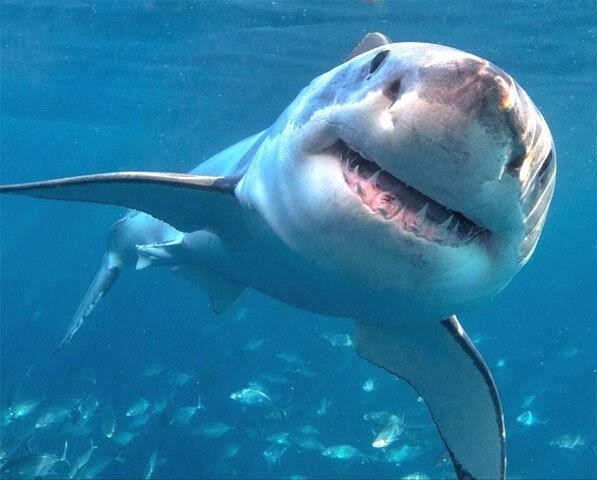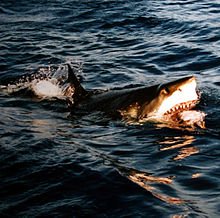Shark

Sharks are a group of elasmobranch fish characterized by a cartilaginous skeleton, five to seven gill slits on the sides of the head, and pectoral fins that are not fused to the head. Modern sharks are classified within the clade Selachimorpha (or Selachii) and are the sister group to the rays. However, the term "shark" has also been (incorrectly used for extinct members of the subclass Elasmobranchii outside the Selachimorpha, such as Cladoselache and Xenacanthus, as well as other Chondrichthyes such as the holocephalid eugenedontidans.
Fossil record:-
Evidence for the existence of shark-like chondrichthyans dates from the Ordovician period, 450–420 million years ago, before land vertebrates existed and before a variety of plants had colonized the continents.Only scales have been recovered from the first supposed elasmobranchians and not all paleontologists agree that these are from true sharks, suspecting that these scales are actually those of thelodont agnathans. The oldest generally accepted "shark" scales are from about 420 million years ago, in the Silurian period. Those animals looked very different from modern sharks.At this time the most common shark tooth is the cladodont, a style of thin tooth with three tines like a trident, apparently to help catch fish. The majority of modern sharks can be traced back to around 100 million years ago. Most fossils are of teeth, often in large numbers. Partial skeletons and even complete fossilized remains have been discovered. Estimates suggest that sharks grow tens of thousands of teeth over a lifetime, which explains the abundant fossils. The teeth consist of easily fossilized calcium phosphate, an apatite. When a shark dies, the decomposing skeleton breaks up, scattering the apatite prisms. Preservation requires rapid burial in bottom sediments.
Buoyancy:-
Unlike bony fish, sharks do not have gas-filled swim bladders for buoyancy. Instead, sharks rely on a large liver filled with oil that contains squalene, and their cartilage, which is about half the normal density of bone. Their liver constitutes up to 30% of their total body mass.The liver's effectiveness is limited, so sharks employ dynamic lift to maintain depth while swimming. Sand tiger sharks store air in their stomachs, using it as a form of swim bladder. Bottom-dwelling sharks, like the nurse shark, have negative buoyancy, allowing them to rest on the ocean floor.
Some sharks, if inverted or stroked on the nose, enter a natural state of tonic immobility. Researchers use this condition to handle sharks safely.
Feeding:-
Most sharks are carnivorous. Basking sharks, whale sharks, and megamouth sharks have independently evolved different strategies for filter feeding plankton: basking sharks practice ram feeding, whale sharks use suction to take in plankton and small fishes, and megamouth sharks make suction feeding more efficient by using the luminescent tissue inside of their mouths to attract prey in the deep ocean. This type of feeding requires gill rakers—long, slender filaments that form a very efficient sieve—analogous to the baleen plates of the great whales. The shark traps the plankton in these filaments and swallows from time to time in huge mouthfuls. Teeth in these species are comparatively small because they are not needed for feeding.
Photo of great white on surface with open jaws revealing meal.
Unlike many other sharks, the great white shark is not actually an apex predator in all of its natural environments, as it is sometimes hunted by orcas
Other highly specialized feeders include cookiecutter sharks, which feed on flesh sliced out of other larger fish and marine mammals. Cookiecutter teeth are enormous compared to the animal's size. The lower teeth are particularly sharp. Although they have never been observed feeding, they are believed to latch onto their prey and use their thick lips to make a seal, twisting their bodies to rip off flesh.
Some seabed–dwelling species are highly effective ambush predators. Angel sharks and wobbegongs use camouflage to lie in wait and suck prey into their mouths. Many benthic sharks feed solely on crustaceans which they crush with their flat molariform teeth.
